Performance Meter
0%
QUESTION ID:1
At the 2-celled stage of Caenorabditis elegans development the blastomeres were experimentally separated and allowed to proceed in development. One of the blastomere (P1) developed generating all types of cells it would normally make while the other blastomere (AB) made only a fraction of the cell types it would normally make. The following conclusion could be drawn:
A. The determination of both P1 and AB was autonomous.
B. The determination of both P1 and AB was conditional.
C. The determination of P1 was autonomous and AB was conditional .
D. Both asymmetric division and cell-cell interactions specify cell fate in early development.
Which of the above combinations is correct?
QUESTION ID:2
Four groups of one-day old female BALB/c neonates had received the following treatments:
A. Epidermal cells from CS7BL/6 male plus anti β2 microglobulin antibody.
B. Epidermal cells from C57BL/6 male plus antibodies to β2 microglobulin, CD40 ligand, CD80 and CD86.
C. Epidermal cells from C57BL/6 female plus anti-CD80 antibody,.
D. Epidermal cells from C57BL/6 female mice. When these BALB/c neonates grew six weeks old, they received skin transplant from C57BL/6 male mice. Transplantation rejection time varied between these four groups. Starting from the fastest to the slowest rejection, which one of the following is the most likely order?
QUESTION ID:3
A mechanical pressure was exerted on a specific location of a peripheral nerve of a mammal. The touch or pain receptors were stimulated from the skin surface innervated by the same nerve. The action potential generated by touch receptor stimulation was blocked beyond the point of mechanical pressure. But the action potential generated by pain receptor stimulation passes through the point of mechanical pressure. Following explanations were offered for these observations:
A. The large diameter 'A' fibres were affected by mechanical pressure
B. The small diameter 'C' fibres were not affected by mechanical pressure
C. The intermediate diameter 'B' fibres were affected by mechanical pressure
D. The large diameter 'A' fibres were not affected by mechanical pressure
Which of the above combinations is correct?
QUESTION ID:4
When a skeletal muscle with an intact nerve supply is stretched, the muscle contracts and the tone increases. The following explanations are offered for this observation: A. Golgi tendon organ was stimulated by the stretching of muscle
B. γ-motor neurons were excited by the stimulated afferent nerve fibres from the stretched muscle
C. Muscle spindle was stimulated by stretching of muscle
D. α-motor neurons were excited by the stimulated afferent nerve fibres from the stretched musscle
Which of the combination is correct?
QUESTION ID:5
Assume that in terms of 'genetic fitness' the 'benefit' of performing an altruistic act to a relative is 500 units and the 'cost' involved is 150 units. Following Hamilton's Rule the act should be performed if the relative is a
QUESTION ID:6
The diagram below depicts a simplified tree of life with three domains and one of the domains including Whittaker's three major kingdoms. Which of the following is the correct naming of the numbered boxes?
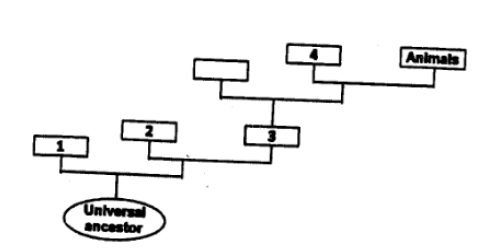
QUESTION ID:7
Sleeping sickness is a disease caused by a protozoan parasite and the following statements pertain to that disease:
A. The vector for this disease is tsetse fly.
B. The vector for this disease is Trypanosoma brucei.
C. The parasite's body is covered by a dense coat of variable surface glycoprotein (VSG).
D. There are several thousands of VSG genes, only one of them expressing at a time, which helps the parasite in evading host's immune response.
E. Several thousand copies of VSG genes express concurrently, paralyzing the host immune system.
Which of the following is the correct combination of the statements given above?
QUESTION ID:8
Fish species X and Y feed on mayfly nymphs in their stream habitat. In a laboratory experiment, the predation intensity of X and Y on their prey was tested under dark (D) and light (L) conditions. Thus, the experimental protocol included four aquaria - LX, LY, DX and DY. In each aquarium containing 100 mayfly nymphs, one fish was introduced and allowed to feed for 30 minutes. Then the fish was removed and the number of mayfly nymphs left uneaten in each aquarium was counted. The results are shown graphically below The most significant conclusion from the results is:

QUESTION ID:9
There are three species of frogs - A, B and C. Species A does not provide parental care for its eggs and larvae. Species B is subjected to predation by a predator that selectively feeds only on small-sized larvae. Species C faces progressively decreasing opportunities for breeding with increasing age. Assuming that resources available for reproduction are similar for A, B and C. Which of the following strategies would have been favored?
QUESTION ID:10
The three graphs (A, B, C) show population growth (N) patterns in relation to N or time (t) Which of the following is correct with reference to the Y-axis label and the type of population growth?
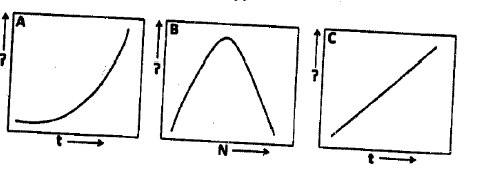
QUESTION ID:11
Which of the following set of observations is true with reference to a comparison of aquatic (A) and terrestrial (T) ecosystems?
QUESTION ID:12
A small lake has three trophic levels- phytoplankton (autotrophs), Zooplankton (herbivore) and planktivorous fish (primary carnivore). Into this lake, a population of piscivorous fish (secondary carnivore) was introduced to study the 'topdown' effects". What is the expected long-term consequence of such an introduction to phytoplankton and zooplankton trophic levels?
QUESTION ID:13
Following is the diagram of three idealized survivorship curves of animals. Find the correct match between the group of animals and the respective survivorship curves.
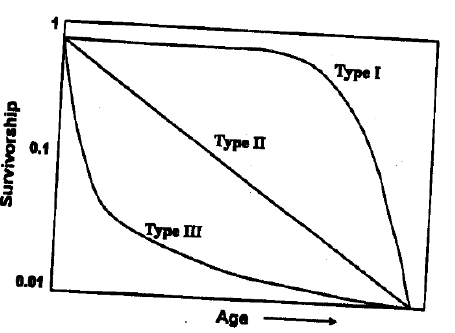
QUESTION ID:14
Following are the characteristics of species that make them more or less prone to extinction: Rare – a Common – b Good dispersal rate – c Poor dispersal rate – d Low specialization – e High specialization – f High variability – g Low variability – h Low trophic status – i High trophic status – j Long life span – k Short life span – l High reproductive output – m Low reproductive output – n Which of the following is the correct combination of characteristics that makes the species more prone to extinction?
QUESTION ID:15
An elderly person suffering from calcium deficiency was advised to take calcium rich food and to supplement the diet with vitamin D. The absorption of calcium in the intestine was increased with the supplementation of vitamin-D. Following explanations were offered for this increased calcium absorption by vitamin D:
A. The synthesis of Calbindin-D9K and Calbindin-D28K in enterocytes was stimulated.
B. The number of Ca2+ -ATPase molecules in enterocytes was increased.
C. The synthesis of divalent metal transporters 1 (DMT1) in the enterocytes was stimulated.
D. The number of hephaestin in the enterocytes was increased.
Which of the above combinations is correct?
QUESTION ID:16
A series of cell lines was created by fusing mouse and human somatic cells. In mouse-human somatic cell hybrids, human chromosomes tend to get lost before becoming a stable cell line. Some hybrid cell lines may carry human chromosome deletions. Each cell line was examined for the presence of chromosomes and for the production of an enzyme. The following results were obtained: Which segment of the chromosome has the gene encoding for the enzyme
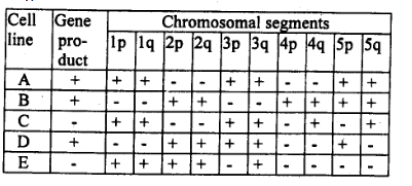
QUESTION ID:17
Upon prolonged illumination, activated rhodopsin does not activate transducing, hence the vision is impaired. This could be because of the following explanations:
A. Most of the activated rhodopsin gets phosphorylated and is unable to activate transducin.
B. Most of the activated rhodopsin gets dephosphorylated and is unable to activate transducin.
C. Arrestin further interacts with phosphorylated rhodopsin.
D. Arrestin further interacts with dephosphorylated rhodopsin.
Which of the above combinations is correct?
QUESTION ID:18
Some key characteristics of the four classes of phylum Mollusca are listed below:
A. They have two lateral (left and right) shells (valves) hinged together dorsally; they do not have distinct head or radula; they disperse from place to place largely as larvae.
B. They generally creep on their foot; the heads of most of this group have a pair of tentacles with eyes at the end; during embryological development, they undergo torsion
C. They have oval bodies with overlapping calcareous plates; underneath the plates, the body is not segmented; they creep along using a broad, flat foot surrounded by a groove or mantle cavity in which the gills are arranged.
D. They have highly developed nervous system; most members of this class have closed circulatory systems.
The correct match of the above characteristics with the classes of Mollusca is
QUESTION ID:19
The following situations might lead to the evolution of monogyny in birds:
A. Male has to assist the female in rearing the offspring.
B. Male guards the female against other males trying to mate with her.
C. One male may not produce enough sperm required to fertilize all the eggs produced by the female.
Which of the above is/are correct?
QUESTION ID:20
The body weight of adult female of a strain of Drosophila is 1.8±0.45 mg (mean ± standard deviation). In a laboratory experiment, each of the 3 groups (A, B, C) of this strain was subjected to a different type of selection pressure having influence on the female body weight. After many generations of experimental selection pressure, the body weight changed as follows: Group A: Body weight distribution - Normal, 1.8 ± 0.08 mg Group B: Body weight distribution - Bimodal at 1.4 and 2.2 mg Group C: Body weight distribution - Normal, 2.2 ± 0.08 mg Which of the following correctly gives the types of selection that have occurred in the three groups?
QUESTION ID:21
A few events in the history of life on earth are given below A. Radiation of mammals and bird; Flourishing of insects and angiosperms B. Primitive plants and fungi colonize land; Diversification of echinoderms. C. Seed plants appear; Fishes and Trilobites abundant; earliest amphibians and insects. D. Earliest birds and Angiosperms appear; Gymnosperms dominant E. Invasion of land by primitive land plants and Arthropods F. Mass marine extinctions; Reptiles radiate; Amphibians decline. Which of the following is a correct match of the above events with the geological period during which they had occurred?
QUESTION ID:22
Following are certain statements regarding the use of Agrobacterium in plant transformation. A.
A. tumefaciens causes crown gall disease and A. rhizogenes causes hairy root disease.
B. Region A in Ti plasmid is responsible for replication. C. Region D in Ti plasmid is responsible for virulence.
D. Oncogenic (one) region in T-DNA is responsible for unusual amino acid synthesis.
Which one of the following combinations of above statements is correct?
QUESTION ID:23
Cultured animal cells were transfected with expression vector encoding either β-galactosidase (β-gal) alone or expressing a fusion protein of β-gal and glucocorticoid receptor (GR). After transfection, cells were kept in presence or absence of Dexamethasone. Immunofluorescence with a labeled antibody specific for β-gal was used to detect the expresseprotein in cytoplasm or nucleus of transfected cells. Possible results of the experiments are:
A. Expression of β-gal alone in the cytoplasm in both absence or presence of Dexamethasone.
B. Expression of β-gal-GR in the cytoplasm in the absence of Dexamethasone.
C. Expression of β-gal alone in the nucleus both in the presence or absence of Dexamethasone.
D. Expression of β-gal-GR in the nucleus in presence of Dexamethasone.
E. Expression of β-gal alone in both cytoplasm and nucleus in presence or absence of Dexamethasone.
F. Expression of β -gal-GR in both cytoplasm and nucleus in presence of Dexamethasone.
Choose the correct combination of results from the following options.
QUESTION ID:24
Four different species concepts are given below:
A. Species separate based on their use of different ecological niches and their presence in different habitats and environments.
B. Differences in physical characteristics or molecular characteristics are used to distinguish species.
C. Species are distinct if they are reproductively isolated.
D. Phylogenetic trees and analyses of ancestry serve to differentiate species.
Which of the following gives the correct names of the above concepts?
QUESTION ID:25
In order to develop a vaccine against a regulatory T cellpromoting but Th 1 suppressing viral infection, four groups (AD) of mice were primed with either killed virus (A) or a virusderived immune dominant peptide (B), or the same peptide but with two substitutions (C) or were left unprimed (D). Upon infection challenge, the order of increasing severity of infection was observed to be B>A>D>C. To explain the contrasting effects of these two peptides (B) and (C), their MHC-binding affinities were assessed but no difference was found. Which of the following possibilities most likely to explain their contrasting effects?
QUESTION ID:26
Marker-assisted selection (MAS) defined as selection based on molecular markers should have some important criterion for plant breeding activities. Some statements about these criteria are mentioned below:
A. Marker should co-segregate with the desired trait of interest.
B. Marker should not co-segregate with the desired trait of interest.
C. Marker should be un-linked with the desired trait of interest.
D. Marker is used for indirect selection of a genetic determinant or determinants of a trait of interest.
Which one of above combinations is correct?
QUESTION ID:27
In a transgenic mice line, lox P sites are introduced in the target gene A in the following manner This transgenic mice line was mated with another transgenic mice line where Cre recombinase is expressed only in B cells. What will be the expression profile of gene A in Cre/lox recombinant mice?

QUESTION ID:28
A hypothetical gene encodes a protein with the following amino acid sequence: Phe- Pro- Thr- Ala- Val-Arg- Ser A mutation of single nucleotide alters the amino acid sequence to Phe- Leu- Leu- Leu- Leu- A second single nucleotide mutation occurs in same gene restoring back the amino acid sequence to the original. The following statements were made regarding the nature and location of the first mutation and that of the intragenic suppressor mutation:
A. The first mutation is a deletion in the second codon.
B. The first mutation is an insertion in the second codon.
C. The intragenic suppressor mutation is an insertion in the second codon
D. The intragenic suppressor mutation is a deletion in the third codon
Which combination of the above statements is correct?
QUESTION ID:29
Three Indian animals -cormorant, lion-tailed macaque and gerbil are to be matched with the ecosystem they inhabit - Wetland (A), Desert (B), Deciduous forest (C), or Rain' forest (D). Which of the following is the correct match of each animal with its habitat?
QUESTION ID:30
The following table summarizes the result of a cross between two strains of Neurospora having the alleles D and d, respectively. The table shows the different patterns of octad arrangement and the number of ascus observed of each type. Based on the above, fill in the blanks from the options given below, "The first two columns are from meiosis with no crossover between locus D and ___[A]___. The pattern for these two columns represent ___[B]___ segregation pattern. The distance between the locus D and the centromere is ___[C]___ map units".
A B C
1. d allele first division 10
2. centromere first division 10
3. d allele second division 20
4. centromere second division 10
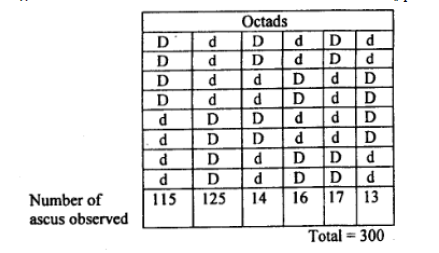
QUESTION ID:31
The inheritance pattern of a common trait which shows complete penetrance is shown below: Based on the above pedigree, fill in the blanks from the options given below: "The trait is __[A]__. The probability that a child from the marriage of individual III-I and III-2 wi11 show the trait is __[B]__ considering that the individual III-I is a carrier of the trait." A B 1. Y-linked 0 2. Y-linked 1/2 3. Autosomal 1/8 4. Autosomal 1/6
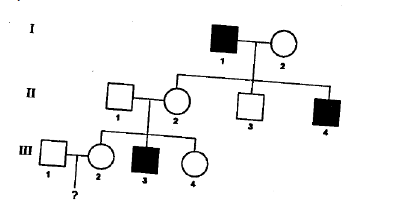
QUESTION ID:32
The following statements were made regarding chromosome pairing (shown in the figure below) and subsequent segregation during meiosis-I in the reciprocal translocation heterozygote:
A. Three ways of segregation in Anaphase I would be: adjacent 1 (vertically in the above figure) adjacent 2 (horizontally) and alternate.
B. Gametes resulting from adjacent 1 and adjacent 2 segregation will be non-viable because of deletions and duplications of several genes.
C. All gametes resulting from alternate segregation will be viable as they will carry both normal chromosomes or both chromosomes having trans locations in the two poles, respectively.
D. A dicentric and an acentric chromosome will be generated following alternate segregation.
Which of the following combination of statements will most appropriately explain the consequence?
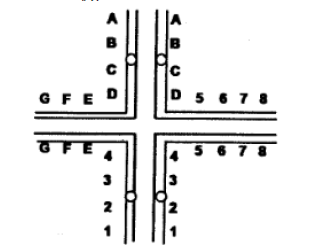
QUESTION ID:33
The list below includes names of animal phyla and classes. A. Echinodermata B. Cephalopoda C. Annelida D. Mollusca E. Hirudinea F. Asteroidea G. Arthropoda H. Crustacea. For a leech and lobster, the correct classification of the of phylum and class, respectively, is
QUESTION ID:34
10 mM acetate buffer (pH 4.00) is diluted one million times with distilled water (pH 7.00). pH of this diluted buffer is: (Help: log10 10x = x; log10 1.10 = 0.04; log10 1.01 = 0.004)
QUESTION ID:35
Consider the structureless oligopeptide R-G-P-S-T-K-M-PE- Y-G-S-T-D-Q-S-N-W-H-F-R. The number of bonds that will be cleaved by trypsin and chymotrypsin treatments separately, are:
QUESTION ID:36
The internal energy of a gas increases by 1J when it is compressed by a force of 1 Newton through 2 metres. The heat change of the system is:
QUESTION ID:37
ΔGo for the base pairing of oligonucleotides (n=5) at 300 K is - 18 kJ mol-1. What would be the approximate value of the equilibrium constant K?
QUESTION ID:38
The reaction of glutamate and ammonia to glutamine and water has a value of + 14 kJ mol-1 for ΔGo. This is coupled with the ATP reaction (ATP + H2O →ADP + phosphate). The ΔGo for this reaction is -30 kJ mol-1. The ΔGo (KJ mol-1) for the coupled reaction Glutamate + NH3 + ATP →Glutamine +ADP + Phosphate under equilibrium condition is

QUESTION ID:39
A protein is composed of leucine, isoleucine, alanine, glycine, proline, one lysine, one arginine and two cysteines connected by a disulfide bond. Conformational analysis indicates that the protein has elements of helix and beta structure. The protein is most likely.
QUESTION ID:40
Given below are some of the methods used to assess evolutionary phylogenetic relationships among plant taxa.
A. 16S rRNA sequence
B. Mitochondrial microsatellite
C. Biochemical characterization
D. Morphology
Which two of the above methods can best reveal the evolutionary phylogenetic relationships?
 TLS Online
TLS Online